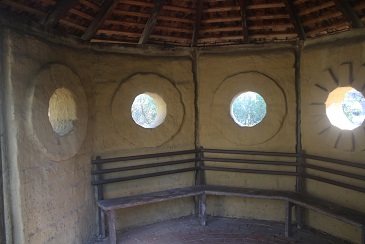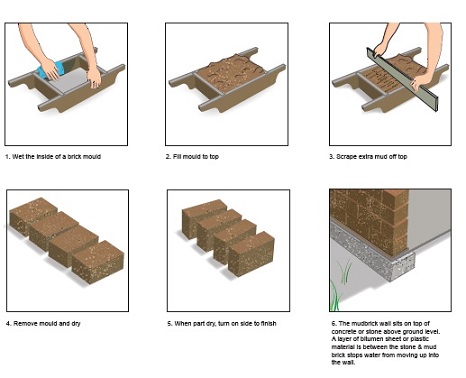Build with Mud

Mud bricks are perhaps the cheapest building material you might imagine, and remarkably easy to work with.
Sure they can erode in the rain if you don't do it right; but there are plenty of ways to protect mud bricks from water.
What Type of Soil Do You Need to Make Your Own Mud Bricks?
Before you build anything with mud bricks, you need to be able to make good quality bricks. The strength and longevity of a mud brick will be influenced by what you make it with, how you make it, and the eroding effects of rain and wind upon it.
All soils contain sand, clay and some organic matter. The best soils for mud bricks would be those classed as 'clays', 'clay loams', 'silty clay loams', or 'silty clays'. A 'sandy clay loam' would require additional clay or organic matter added (e.g. straw) to make an effective brick mixture. Some types of earth can simply be mixed with water to a particular consistency, and then put into a mould to create a brick without the need to mix in other materials.
Different proportions of clay, sand and organic matter in soil affects the characteristics of bricks as follows:
- It can become more likely to crack or crumble.
- It can lose structural strength (becoming less capable of supporting heavy weights).
- It can become more prone to erosion.
Although making mud bricks is relatively simple, it can be quite daunting if you've never made them before. The renowned Chinese Mud Brick Builder, Lin Wei-Hao has suggested the following tips for different soils:
- Clay content can be as high as 85% - but straw or another binding material needs to be mixed in to make the earth hold together.
- Soils with 25-40% sand can be used without the need for straw.
- Soil with less than 15% sand can be used so long as it has a reasonable level of plasticity and straw is added.
Tip: To bond mud bricks you don't use cement - simply use the same mud mix used for creating the bricks to join them.
How to Make Mud Bricks
The process involved in making a mud brick is basically as follows:
- Obtain the right type of soil. Very sandy soils are not suitable. Most clay type soils are fine, but you may need to add straw or some other fibrous material to those high in clay content.
- Make a mould. This is easily done using timber slats fixed together with rectangular spaces in between. Set it down on the ground.
- Mix the soil with water until it has a plastic consistency. This can be done mechanically (cement mixer) or by hand.
- Place the mixed mud in the mould and tamp it down. Remove the mould when the bricks have partially dried.
- Leave the bricks to dry slowly out of direct sunlight (otherwise they may crack). This can be done by laying the bricks out under cover e.g. beneath sheets of metal or plastic. In warm weather they can be dried and ready for use within a week. In cold or humid conditions they take longer.

If you decide to make your own mud bricks you should be aware that it is very time consuming, especially if you're planning on building your house out of them. Two people who are working may be able to make say 100 to 200 bricks a week on the weekends but for an average house you're probably going to need something in the region of 10,000 bricks. At that rate it could be a couple of years before you have enough bricks.
[14/03/2025 22:42:50]